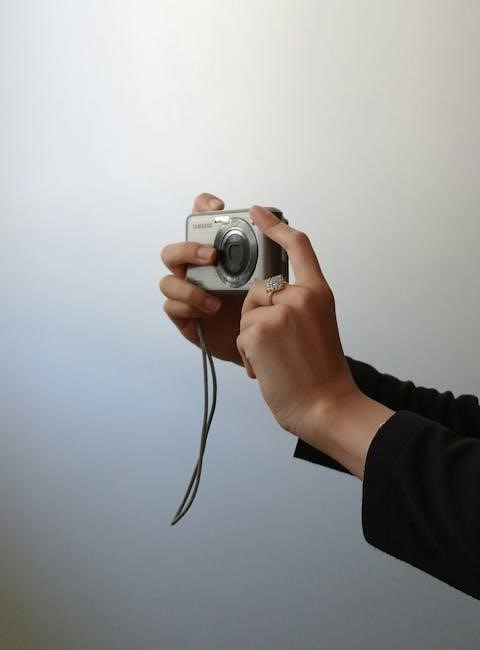A manual remote control for air conditioning offers convenient operation, allowing users to adjust settings like temperature, fan speed, and modes effortlessly from a distance, enhancing comfort and efficiency.

Types of Remote Controls for Air Conditioning Units
Remote controls for AC units include infrared, Wi-Fi, and universal types, each offering distinct features like smart app integration and compatibility with various brands for enhanced functionality.
2.1. Infrared Remote Controls
Infrared (IR) remote controls are traditional devices that use infrared signals to communicate with air conditioning units. They operate within a specific range, typically up to 10 meters, and require a direct line of sight between the remote and the AC unit’s IR receiver. These remotes are widely used due to their simplicity and reliability. They often feature basic functions like temperature adjustment, fan speed control, and mode selection. IR remotes are generally battery-powered and require periodic maintenance, such as cleaning the sensor and replacing batteries. While they lack advanced features like Wi-Fi connectivity, they remain popular for their ease of use and compatibility with most standard AC units. Regular cleaning of the IR sensor ensures optimal performance and prevents signal interference.
2.2. Wi-Fi and Smart Remote Controls
Wi-Fi and smart remote controls represent the next generation of air conditioning management, offering advanced functionality and convenience. These devices connect to the internet, enabling control via smartphones or tablets through dedicated apps. Users can adjust settings, monitor energy usage, and receive maintenance alerts remotely. Smart remotes often integrate with IoT systems, allowing voice control through assistants like Alexa or Google Home. They also support features like scheduling, geofencing, and energy optimization. Compatibility with various AC brands and models ensures widespread usability. Setup typically involves pairing the remote with the AC unit and syncing it with a smartphone app. These remotes enhance user experience by providing real-time feedback and customizable settings, making them a popular choice for modern smart homes. Their ability to learn usage patterns and adapt settings improves comfort and efficiency over time.
2.3. Universal Remote Controls
Universal remote controls are versatile devices designed to work with multiple air conditioning brands and models, offering flexibility for users with diverse AC systems. These remotes operate by transmitting specific infrared codes, which can be programmed to match the commands of various AC units. They often feature a comprehensive button layout, allowing users to adjust temperature, fan speed, and operating modes seamlessly. Setup may involve selecting the correct brand code or learning the commands from the original remote. Universal remotes are particularly useful for replacing lost or damaged originals or for controlling multiple AC units with a single device. They are cost-effective and convenient, providing a unified control solution for different systems. Their compatibility and ease of use make them a practical choice for both residential and commercial settings, ensuring consistent comfort and efficiency across various environments.

Functions of a Remote Control
A remote control enables users to adjust settings like temperature, fan speed, and operating modes, ensuring seamless operation of the air conditioning system from a distance.
3.1. Basic Functions
The basic functions of a remote control for air conditioning include turning the unit on/off, adjusting temperature settings, and selecting modes such as cooling, heating, or fan-only operation. These essential features allow users to maintain a comfortable environment with ease. The remote typically includes buttons for increasing or decreasing the temperature, switching between modes, and controlling fan speed. Additionally, some remotes feature a “Follow Me” function, which ensures the remote continuously sends signals to the AC unit for consistent operation. Proper use of these functions requires maintaining a clear line of sight and staying within the recommended operating distance to ensure reliable signal transmission and optimal performance. Regular maintenance, such as replacing batteries, is also crucial to preserve functionality. By utilizing these basic functions effectively, users can enjoy efficient and convenient climate control in their spaces.
3.2. Advanced Features
Advanced features of manual remote controls for air conditioning include smart technology integration, such as Wi-Fi connectivity, allowing users to control their AC units via smartphone apps. Some remotes offer scheduling capabilities, enabling users to pre-set temperatures and modes for energy efficiency. Additionally, features like air quality sensors and advanced fan speed controls provide enhanced comfort. Certain models include voice command compatibility, further simplifying operation. These advanced functions not only improve convenience but also optimize energy usage, making them ideal for modern smart home setups. By leveraging these features, users can achieve a more personalized and efficient climate control experience; Proper use of these advanced functions requires familiarization with the remote’s settings and ensuring compatibility with the AC unit. Regular updates to the remote’s software can also enhance performance and add new functionalities.
3.3. Button Guide
Understanding the buttons on your manual remote control is key to optimal use. The MODE button allows you to switch between cooling, heating, fan, and dry modes. The FAN button adjusts fan speed, offering options like Auto, Low, Medium, and High. To set the desired temperature, use the UP and DOWN arrows. The ON/OFF button powers the unit on and off. Some remotes include a FOLLOW ME button for precise temperature control. Properly using these buttons ensures efficient operation. Regularly reviewing the button functions helps maximize comfort and energy savings. Always refer to the user manual for specific button layouts and additional features, as designs may vary between models. This guide provides a clear overview to help users navigate their remote controls effectively.

Installation and Setup
Installation involves pairing the remote with the AC unit, configuring settings, and ensuring proper signal reception within the recommended range for optimal functionality.
4.1. Pairing the Remote with the AC Unit
To pair the remote with your air conditioning unit, start by turning on the AC and ensuring the remote is within the recommended operational range. Locate the pairing button on the remote or unit, typically labeled as “PAIR” or “SYNC.” Press and hold this button until an LED light flashes or a beep is heard, indicating the pairing mode is active. Release the button and wait for the remote to establish a connection with the AC unit. Once paired successfully, the LED light will stop flashing, and the remote will respond to button presses. Ensure no obstructions block the signal for a stable connection. If pairing fails, restart the process or consult the user manual for specific instructions.
4.2. Recommended Distance for Operation
The recommended operational distance for a manual remote control with an air conditioning unit typically ranges between 8 to 10 meters. This ensures a stable signal transmission without interference. The remote should be pointed directly at the AC unit’s infrared receiver for optimal performance. Physical obstructions, such as walls or furniture, can reduce the effective range, so it’s important to maintain a clear line of sight. Users should also avoid exposing the remote to direct sunlight or moisture, as these factors can weaken the signal. If the remote fails to respond, check the distance and eliminate any obstructions. For precise guidelines, refer to the user manual, as specific models may have varying recommendations based on their design and technology.
4.3. Universal Remote Configuration
Configuring a universal remote control for your air conditioning unit involves several steps to ensure compatibility and proper functionality. Begin by locating the specific code for your AC unit’s brand, typically found in the remote’s user manual or on the manufacturer’s website. Enter the code by following the programming instructions, which may involve pressing and holding a button to activate the remote’s programming mode. Once the code is entered, test the remote by turning the AC unit on and adjusting settings like temperature or fan speed to confirm it works correctly. If the initial code doesn’t function, try an alternative code or use the remote’s auto-search feature to find the correct one. Ensure the remote is within the recommended operational distance and that there are no obstructions blocking the signal path. Refer to the manual for troubleshooting tips, such as addressing low battery issues or signal interference, to maintain optimal performance. Additionally, keep the remote’s infrared sensor clean to ensure reliable communication with the AC unit. By carefully following these steps, you can successfully configure your universal remote and enjoy seamless control over your air conditioning system.

Maintenance and Care
Regular maintenance ensures optimal performance. Clean the remote’s surface and sensor, replace batteries promptly, avoid signal obstructions, and store the remote safely for reliable operation.
5.1. Battery Maintenance
Proper battery care is essential for remote functionality. Replace batteries when power weakens, using the correct type to avoid damage. Remove batteries during long inactivity to prevent leakage and corrosion. Clean terminals regularly for optimal connectivity. Ensure batteries are inserted correctly, following polarity guidelines. Store spare batteries in a cool, dry place. Avoid mixing old and new batteries to maintain consistent voltage. If the remote will be unused for an extended period, remove batteries to prevent damage. Always use high-quality batteries for reliable performance. Regular checks and maintenance ensure the remote remains operational and responsive, providing uninterrupted control over your air conditioning system.
5.2. Cleaning the Remote Sensor
Regularly cleaning the remote sensor ensures optimal performance and signal transmission. Use a soft, dry cloth to gently wipe away dust or debris from the sensor and buttons. Avoid harsh chemicals or liquids, as they may damage the components. If the sensor is obstructed by objects or furniture, relocate the remote or the AC unit for unimpeded communication; Ensure the remote is within the recommended operating distance, typically 8-10 meters, for reliable functionality. Clean the AC unit’s infrared sensor as well to maintain strong signal reception. Proper maintenance prevents signal interruption and ensures consistent control over your air conditioning system.
Troubleshooting Common Issues
Common issues with manual remote controls include unresponsiveness, signal interference, and battery depletion. Check batteries, ensure the sensor is clean, and verify the remote is within range.
6.1. Remote Not Responding
If the remote control fails to respond, check the batteries first, ensuring they are installed correctly and not depleted. Clean the remote’s infrared sensor and the AC unit’s receiver to ensure clear communication. Verify there are no obstructions blocking the signal path, as physical barriers can interrupt infrared transmission. Ensure the remote is operated within the recommended distance, typically up to 10 meters; If issues persist, consult the user manual for troubleshooting steps or reset the remote by removing and reinstalling the batteries. In some cases, re-pairing the remote with the AC unit may be necessary. If none of these steps resolve the issue, contact the manufacturer or a professional for further assistance.
6.2. Signal Interruption Solutions
Signal interruptions can often be resolved by addressing physical obstructions or interference. Ensure the remote’s line of sight to the AC unit is unobstructed, as curtains, furniture, or walls can block the signal. Verify that the remote is within the recommended operating distance, typically up to 10 meters. If the issue persists, check for nearby electronic devices that may cause interference, such as TVs or routers, and move them away. Clean the remote’s infrared sensor and the unit’s receiver to ensure clear communication. Replace batteries if they are weak, as low power can cause intermittent signal loss. Finally, test the remote from different angles to find the optimal operating position. These steps should restore reliable communication between the remote and the AC unit.
Compatibility with Different AC Brands
Universal remote controls are compatible with multiple AC brands, including Panasonic and Midea, ensuring seamless operation across various models, though some may require manual configuration for optimal performance.
7.1. Compatible Brands
Manual remote controls are designed to work with various air conditioning brands, including Panasonic, Midea, and Trane, ensuring broad compatibility. These remotes often support universal configurations, making them adaptable to different models. For instance, Panasonic’s CONEX system is tailored for their commercial AC units, while Midea’s universal remotes can integrate with multiple brands. Compatibility ensures seamless operation, allowing users to control temperature, fan speed, and modes effortlessly. Some remotes may require manual setup or code pairing, but they generally function across a wide range of devices. This versatility makes manual remotes a practical choice for users with diverse AC brands in their homes or workplaces.
7.2. Ensuring Compatibility
To ensure compatibility of a manual remote control with an air conditioning unit, users should first identify the brand and model of their AC. Many universal remotes come with a list of compatible codes for various brands. By referencing the user manual, users can input the correct code to establish communication. For example, Panasonic’s CONEX system requires specific pairing steps, while Midea’s remotes may need code input from a predefined table. Additionally, maintaining a clear line of sight and staying within the recommended operational distance helps ensure reliable signal transmission. Regular updates to the remote’s firmware can also enhance compatibility with newer AC models. Proper setup and configuration are key to achieving optimal performance and seamless control.
Smart Technology Integration
Smart technology integrates manual remotes with IoT systems, enabling control via smartphones and tablets, enhancing efficiency and offering advanced features like scheduling and energy monitoring.
8.1. IoT and Remote Control
The integration of IoT technology with remote controls enhances the functionality of air conditioning systems, enabling seamless control via smartphones and tablets. This advanced system allows users to adjust temperature settings, monitor energy consumption, and schedule operations remotely. IoT-enabled remotes provide real-time feedback, ensuring optimal performance and energy efficiency. For instance, Panasonic’s CONEX system exemplifies this innovation, offering a cable-based IoT solution for commercial AC units. Such systems minimize manual intervention, allowing users to manage their AC units intelligently. The IoT and remote control combination not only improves convenience but also supports eco-friendly practices by optimizing energy use. This integration is a significant leap forward in smart home technology, making air conditioning control more accessible and efficient than ever before.
8.2. Smartphone App Control
Smartphone app control revolutionizes air conditioning management, offering unparalleled convenience and flexibility. Users can adjust temperature, fan speed, and modes directly from their devices, ensuring comfort without physical interaction. Panasonic’s CONEX system exemplifies this, enabling seamless control via smartphones and tablets. Apps provide real-time feedback, allowing users to monitor and optimize energy consumption. Features like scheduling and geofencing further enhance efficiency, automatically adjusting settings based on user presence. Compatibility with various AC brands ensures widespread usability, making smartphone app control a versatile solution for modern households and commercial spaces. This technology not only simplifies AC management but also promotes energy-saving practices, making it a essential tool for smart home enthusiasts. The integration of app control with IoT devices underscores its role in advancing air conditioning technology.
User Guides and Manuals
User guides and manuals provide detailed instructions for installing, operating, and troubleshooting air conditioning remote controls, ensuring optimal performance and ease of use for all users.
9.1. Initial Setup Guide
Setting up your air conditioning remote control begins with inserting batteries and syncing it with the AC unit. Ensure the remote is within range and pointed at the indoor unit’s receptor. Press and hold the power button to activate pairing mode, following the manufacturer’s instructions. Once connected, test basic functions like turning the unit on/off and adjusting temperature settings. Familiarize yourself with button layouts and modes (e.g., COOL, FAN, AUTO). Refer to the manual for specific model instructions, as procedures may vary. Proper setup ensures smooth operation and optimal performance of your air conditioning system.
9.2. Mode Functionality Explanation
The remote control offers multiple modes to customize your air conditioning experience; The AUTO mode automatically adjusts settings based on room temperature, while COOL actively lowers the temperature. DRY mode reduces humidity without cooling, and FAN mode circulates air without changing the temperature. Some remotes also feature a HEAT mode for warming the room. Each mode is selected using the MODE button, cycling through options. Additional settings like fan speed (Auto, Low, Medium, High) can be adjusted separately. Understanding these modes allows you to optimize comfort and energy use. Always refer to your manual for model-specific mode functionalities, as features may vary. Proper mode selection ensures efficient operation and tailored climate control for your space.

Safety Tips
Always maintain a clear line of sight between the remote and AC unit. Keep the remote out of children’s reach and avoid signal obstructions for optimal performance.
10.1. Proper Usage Guidelines
Always keep the remote control out of children’s reach to avoid accidental damage or unintended AC operation. Ensure a clear line of sight between the remote and the AC unit for uninterrupted signal transmission. Replace batteries promptly when low to maintain consistent performance. Avoid exposing the remote to water or extreme temperatures, as this could damage its internal components. Use the remote within the recommended distance range to ensure reliable operation. Never attempt to modify or disassemble the remote, as this may void the warranty or cause malfunctions. Regularly clean the remote’s surface and sensors to ensure optimal functionality. Refer to the user manual for specific guidelines tailored to your AC model.
10.2. Avoiding Signal Obstruction
Ensure no objects block the line of sight between the remote control and the AC unit’s receiver, as this can interfere with signal transmission. Curtains, furniture, or other obstacles placed in front of the AC unit can weaken or completely block the infrared signal. Keep the remote and receiver free from dust and debris, as these can obstruct the sensors. Avoid placing electronic devices near the receiver, as they may cause signal interference. Maintain a clear path for the remote’s infrared signals to ensure smooth operation. Regularly inspect the area around your AC unit to identify potential obstructions and relocate them if necessary. Proper placement and maintenance will help prevent signal issues and ensure reliable control over your air conditioning system.
Energy Efficiency
Manual remote controls help optimize energy use by allowing precise temperature and fan speed adjustments, reducing unnecessary cooling and saving energy. Smart scheduling features further enhance efficiency.
11.1. Optimizing Energy Use
Manual remote controls play a crucial role in optimizing energy consumption for air conditioning systems. By allowing users to adjust temperature settings, fan speeds, and operation modes precisely, these remotes help avoid unnecessary cooling. For instance, setting the right temperature can prevent excessive energy use while maintaining comfort. Additionally, features like smart scheduling enable users to program their AC units to operate only when needed, further reducing wasted energy. This level of control ensures that the system runs efficiently, lowering overall energy consumption and utility bills. Regular maintenance, such as cleaning the remote sensor and ensuring proper signal transmission, also supports optimal performance and energy savings.
11.2. Smart Scheduling
Smart scheduling enhances energy efficiency by allowing users to pre-program their air conditioning units to operate during specific times. This feature, often integrated with IoT-enabled remotes, ensures the AC runs only when needed, reducing energy waste. For example, users can set the system to cool the room before they arrive home or turn it off when the space is unoccupied. Advanced systems, like Panasonic’s CONEX, offer seamless scheduling through smartphone apps, providing greater flexibility and control. By automating operations, smart scheduling minimizes manual adjustments and optimizes energy use, leading to lower utility bills and a reduced environmental impact. This feature is particularly beneficial for busy households or commercial spaces with predictable occupancy patterns.
